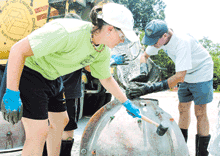 |
| By Alison Harbaugh
-- The Capital |
 |
Meghan Hoffman and Kevin
McMenamin work on a mold for a reef
ball. | | Anglers create reef balls for underwater
habitat
By
PAMELA WOOD, Staff Writer
They're dome-shaped, made of concrete and full of holes. And
they'll make a great home for oysters, fish and other critters.
In the searing heat yesterday, a crew of volunteers created the
latest set of "reef balls" that they'll sink in the Chesapeake Bay
later this summer.
"You get an ecosystem
developing on the reef, from microscopic organisms to flora and
fauna," said Pete Abbott, vice president of the Annapolis chapter of
the Maryland Saltwater Sportfishermen's Association. The group is
spearheading the reef ball effort, designed to improve fishing and
help the environment.
For the past two
weeks and through next week, MSSA volunteers are pouring and
"hatching" the reef balls at Discovery Village, an environmental
center in Shady Side.
Creating the reef
balls involves piecing together round molds and strategically
placing inflatable balls inside to create the igloo-like shape and
holes of various sizes for fish to swim in and out of.
Once the molds are secure, concrete is poured
from a truck via a long chute. Volunteers then follow behind and tap
the molds to get rid of any air bubbles.
After drying, the reef balls are "hatched"
from the molds, looking something like giant concrete whiffle
balls.
It takes about a month of curing
before the reef balls are plunked about 35 feet deep in the
Chesapeake Bay. The launching point will be just off of Hackett
Point on the Broadneck Peninsula.
Once in
the water, the reef balls should attract oysters that attach to the
surface, and fish and crabs seeking shelter.
The lessons weren't lost on a group of Cape
St. Claire Elementary School students who helped out yesterday.
Four of the five boys said they like fishing.
And all five - Zion Meer, Drew McMenamin, Andre Maddox, Sean
McMenamin and Ian Hourican - were able to explain how the reef balls
will provide an attractive home for oysters and fish.
The fun of playing with cement out in the sun
wasn't lost on them, either.
"It's fun
doing it," said Zion, age 9.
"It's hard
work," said 7-year-old Sean. "It's something new that we hadn't
tried before."
The project has been two
years in the making for the fishing club, which got the idea from
another chapter.
After two years of
planning, the club lined up a $22,000 grant from the Chesapeake Bay
Trust, the nonprofit group that distributes the proceeds from the
"Treasure the Chesapeake" license plates.
The fishermen also enlisted the help of
Discovery Village, the Chesapeake Bay Foundation and the Maryland
Environmental Service, an independent state agency that carries out
environmental projects.
C.D. Dollar, a
spokesman for the statewide MSSA, said the reef ball project is an
example of how private citizens can team up with the government and
nonprofit groups to take action to improve the bay.
"Government can't do it all and private
citizens can't do it all," he said.
Next
Top Story
Top Stories
Page
Subscribe
to The Capital
Published June 22, 2006, The Capital, Annapolis,
Md.
Copyright © 2006 The Capital, Annapolis,
Md. |







